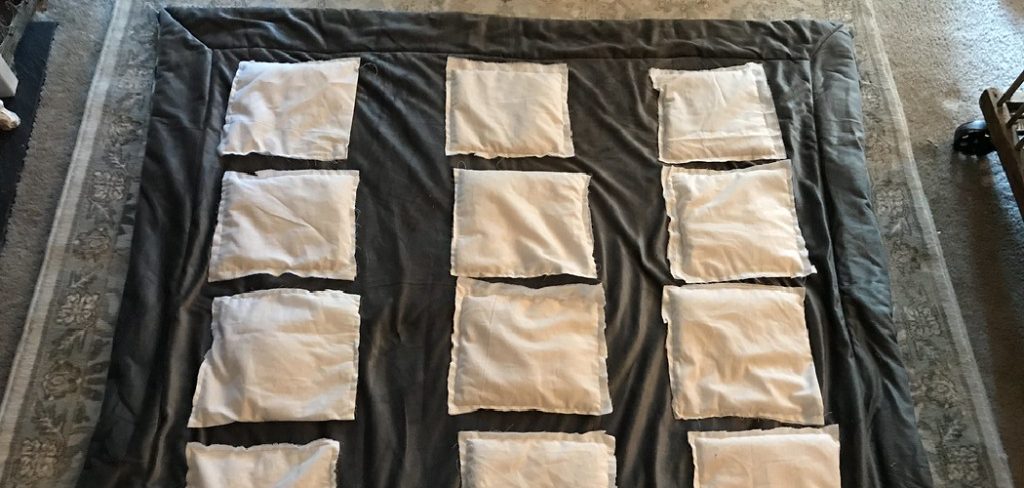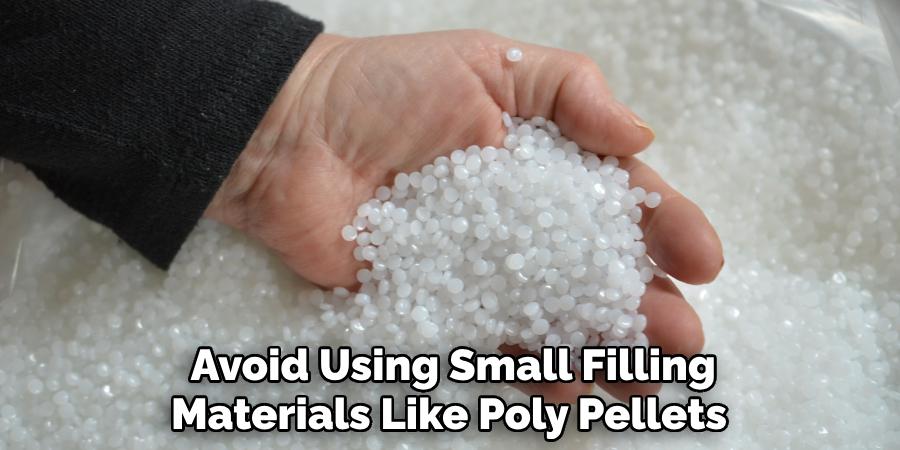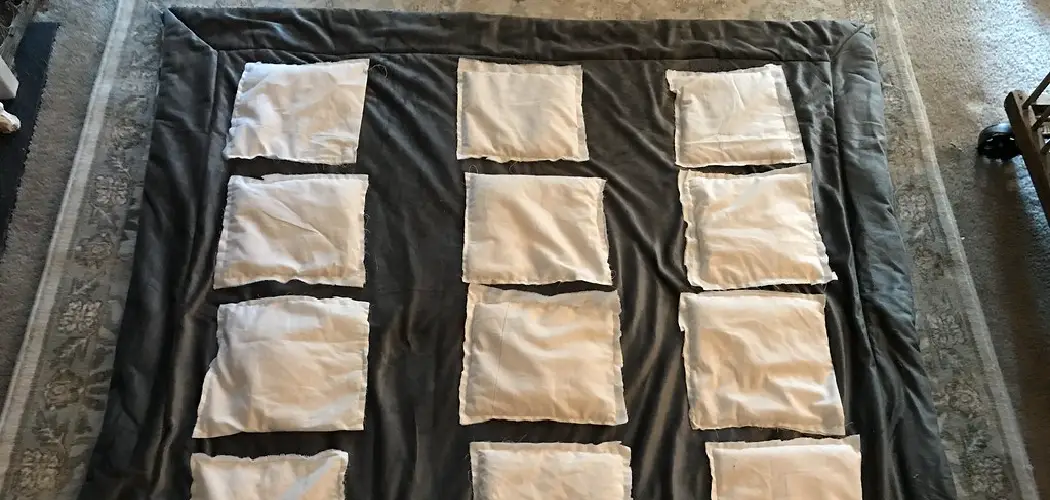Weighted blankets have been gaining popularity in recent years, and for good reason. These blankets are filled with weighted materials such as plastic pellets or glass beads, which provide a gentle pressure on the body when used. This deep touch pressure has been found to have many benefits, including reducing anxiety and promoting relaxation.

The main advantage of making a weighted blanket is that you can create a customized and personalized product for yourself or your loved ones. By choosing the fabric, weight, and size, you can tailor the blanket according to their preferences and needs.
Additionally, making a weighted blanket at home can be more cost-effective compared to purchasing one from a store. In this blog post, You will learn in detail how to make a weighted blanket.
Materials You Will Need
- Fabric (Cotton or Flannel are ideal choices)
- Weighted filling material (such as plastic pellets, glass beads, rice, or poly-pellets)
- Sewing machine
- Thread
- Scissors
- Measuring tape
- Pins
- Ruler or yardstick
- Marking tool (fabric pencil or chalk)
- Polyfill stuffing (optional)
Step by Step Processes for How to Make a Weighted Blanket
Step 1: Inspect the Fabric
Before embarking on your journey to make a weighted blanket, it is important to carefully inspect the fabric you will be using. Ensure that it is of good quality and can withstand the weight of filling materials. Also, check for any tears or holes in the fabric which could cause problems during the sewing process.
Step 2: Choose Your Filling Material
The next step is to choose the filling material for your weighted blanket. Some popular options include poly pellets, glass beads, rice and dried beans. Each of these materials has its own pros and cons, so do some research and decide which one would be best suited for you.
Step 3: Calculate the Weight of Your Blanket
To make a weighted blanket that is effective, it is important to calculate the weight correctly. As a general rule of thumb, the blanket should be around 10% of your body weight plus one or two pounds for extra pressure. Using a measuring tape and scissors, carefully cut the fabric according to the desired size of your weighted blanket. Remember to add an extra inch on each side for the seam allowance.

Step 4: Pin and Sew the Fabric
Once you have cut the fabric, pin together the right sides facing inwards and carefully sew around three edges, leaving one end open. This will serve as the opening for filling in your chosen materials. Now comes the fun part – filling your blanket! Use a funnel or a measuring cup to carefully pour the filling material into the blanket. Make sure to distribute it evenly and leave around two inches of space at the top.
Step 5: Sew the Final Edge
After filling your blanket, carefully sew up the final edge using a needle and thread. This will ensure that none of the filling materials escape during use. To give your weighted blanket a professional look, you can add some finishing touches such as a decorative border or tassels. Get creative and make it uniquely yours!
Step 6: Wash and Dry Your Blanket
It is important to wash and dry your weighted blanket before use to ensure that it is clean and free of any excess filling materials. Follow the fabric care instructions to avoid damaging your blanket.
Congratulations, you have successfully made your very own weighted blanket. Curl up under it and enjoy the calming sensation of its gentle pressure. Experiment with different filling materials and fabric patterns to find the perfect weighted blanket for you.
Tips for How to Make a Weighted Blanket
- When working with heavy materials such as poly pellets, always make sure to have a sturdy surface to work on. This will prevent any accidents or spills from occurring.
- Use caution when handling scissors and other sharp objects while cutting materials for your weighted blanket. Always cut away from your body and keep fingers away from the blade.
- Ensure that all materials are securely attached to the blanket. Loose materials can be a choking hazard, especially if you have young children or pets in the house.
- Make sure to read and follow all instructions carefully when using any tools or equipment such as sewing machines or irons. The manual will provide important safety information specific to each device.
- If you are allergic to certain materials, make sure to wear gloves and a mask while handling them. This will prevent any allergic reactions from occurring.
- Always supervise children and pets when using weighted blankets. Although they are safe for use, it’s important to ensure that they are used properly and do not pose a suffocation risk.
- If you have any doubts or concerns about the process of making a weighted blanket, consult an expert or seek guidance from online tutorials and resources before proceeding. It’s better to be safe than sorry, especially when it comes to the safety of your loved ones.

Are There Any Specific Measurements for the Weight of the Blanket?
When it comes to making a weighted blanket, the weight is a crucial factor. The weight of your blanket will determine its effectiveness in providing comfort and inducing relaxation. Generally, weighted blankets should be around 10% of an individual’s body weight. However, this can vary depending on personal preference and specific needs. Some may find that a lighter or heavier blanket works best for them, while others may have medical conditions that require a certain weight.
So, before you start making your weighted blanket, it’s essential to determine the ideal weight for you or whoever will be using it. This can be done by consulting with a healthcare professional or experimenting with different weights until you find what works best. Another aspect to consider is the size of the blanket.
A general rule of thumb is to make the weighted area 2-3 inches smaller than the overall size of the blanket. This will ensure that the weight is evenly distributed and doesn’t shift around too much.
How Do You Wash and Maintain the Weighted Blanket?
After spending time and effort to make your own weighted blanket, it is important to properly care for it in order to prolong its lifespan and maintain its quality. Here are some tips on how to wash and maintain your weighted blanket:
Washing Instructions
- Check the label – Before washing your weighted blanket, always check the manufacturer’s instructions or the label attached to it. Some blankets may have specific washing instructions, such as hand-washing only or using a gentle cycle.
- Spot clean – If there are any stains on your weighted blanket, try to spot clean it first before resorting to a full wash. Use a damp cloth and mild detergent to gently scrub the stained area.
- Machine wash – Most weighted blankets can be washed in a machine, but be sure to use a gentle cycle and cold water. Avoid using hot water as it can damage the filling of the blanket.
- Use mild detergent – When washing your weighted blanket, use a mild detergent that is free from harsh chemicals and fragrances. This will help protect the fabric and maintain its softness.
- Don’t overload – Make sure to only wash your weighted blanket with other lightweight items. Overloading the washing machine can cause damage to both the blanket and the machine.
- Rinse thoroughly – After washing, make sure to rinse your weighted blanket thoroughly to ensure all detergent residue is removed. Leftover detergent can cause irritation to sensitive skin.
- Hang to dry – It is best to air-dry your weighted blanket rather than using a dryer. This will help maintain the quality of the fabrics and prevent any shrinkage.

Maintenance Tips
- Store properly – When not in use, make sure to store your weighted blanket in a dry and clean place. Avoid storing it in plastic bags or containers as this can trap moisture and cause mildew.
- Avoid excessive sunlight – Direct exposure to sunlight can cause the fabric of your weighted blanket to fade and weaken. It is best to avoid hanging it outside for extended periods.
- Shake regularly – To keep the filling inside your weighted blanket evenly distributed, give it a good shake every now and then. This will prevent any clumping or shifting of the filling.
- Use a duvet cover – Using a duvet cover can help protect your weighted blanket from stains and spills. It is also easier to wash and maintain a duvet cover than the entire blanket.

By following these tips, you can ensure that your weighted blanket remains clean, soft, and comfortable for years to come. Remember to always check the manufacturer’s instructions before washing or storing your weighted blanket, and give it the proper care it deserves.
What Are Some Additional Benefits of Using a Weighted Blanket Aside From Better Sleep?
Weighted blankets have gained popularity in recent years due to their numerous benefits. They are known to improve sleep quality, reduce stress and anxiety, and promote relaxation. But did you know that there are other materials you can use for the filling instead of weighted beads? In this section, we will discuss some alternatives to consider. One popular alternative is using poly pellets as a filling.
These small, plastic pellets are commonly used in doll making and can also provide the weight needed for a weighted blanket. They are more affordable compared to weighted beads and can be found in craft stores or online. Another option is using dried beans or rice as filling.

These materials are easily accessible and budget-friendly, making them a popular choice for DIY projects. However, they may not provide as much weight as weighted beads or poly pellets, so you may need to use more of them to achieve the desired heaviness.
What Are Some Additional Benefits of Using a Weighted Blanket Aside From Better Sleep?
Aside from aiding in sleep, weighted blankets have also been reported to provide relief for those with sensory processing disorders, ADHD, and autism. The deep pressure stimulation created by the weight of the blanket can help calm the nervous system and improve focus. Weighted blankets have also been used in therapy for individuals with PTSD and other anxiety disorders.
Furthermore, using a weighted blanket can also be beneficial for those who experience chronic pain. The weight of the blanket can provide a gentle, comforting pressure that can help alleviate tension and promote relaxation in the muscles. Lastly, some people have reported feeling more grounded and secure when using a weighted blanket.
This can be especially helpful for those who struggle with feelings of anxiety or restlessness. Overall, there are many potential benefits to using a weighted blanket, making it a versatile and worthwhile investment for anyone looking to improve their overall well-being.
Can You Make a Child-sized Weighted Blanket Following the Same Instructions?
Yes, you can make a child-sized weighted blanket following the same instructions as making an adult-sized one. However, it is important to take into consideration the weight and size of the child when determining the appropriate amount of filling to use.
It is recommended to consult with a doctor or occupational therapist for guidance on the correct weight and size for a child’s weighted blanket. Additionally, for safety purposes, it is important to avoid using small filling materials like poly pellets or dried beans that could potentially be a choking hazard for young children.

Using larger and safer filling options like weighted beads or a weighted blanket insert may be more suitable for child-sized blankets. It is also important to supervise children when using a weighted blanket and make sure they are able to easily remove it if they become uncomfortable. With proper care and supervision, a child-sized weighted blanket can provide the same benefits as an adult-sized one and help promote better sleep and relaxation for children.
Conclusion
In conclusion, it’s clear that weighted blankets are a great way to improve sleep and reduce stress and anxiety. Whether you’re looking to make one for yourself or as a gift, the process is relatively simple and can be customized to fit your needs. When making a weighted blanket, remember to choose materials that are durable yet comfortable. This will ensure that your blanket stays in good condition and provides the desired amount of weight.
Additionally, make sure to follow a proper sewing pattern and securely attach the weights to prevent them from shifting. Taking these extra precautions will result in a high-quality weighted blanket that can provide years of comfort and relaxation. Lastly, don’t be afraid to get creative with your designs and fabrics.
Adding personal touches can make the blanket even more special and enjoyable to use. I hope this article has been beneficial for learning how to make a weighted blanket. Make Sure the precautionary measures are followed chronologically.

